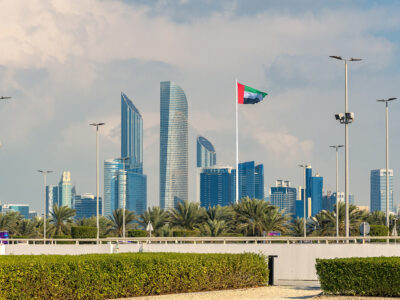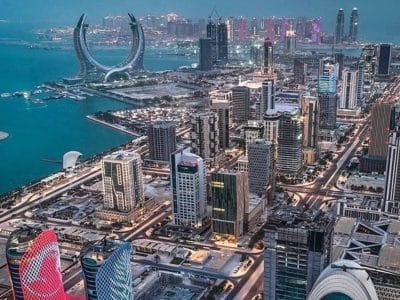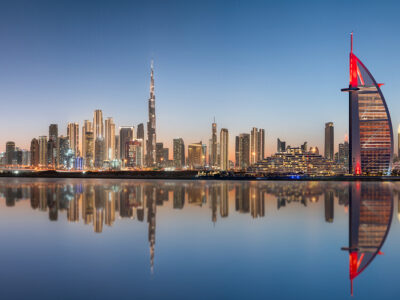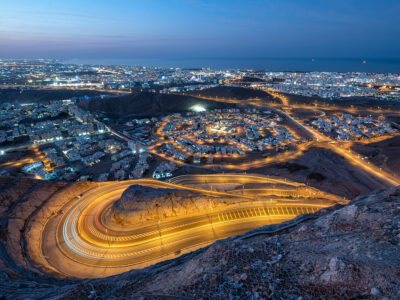In January, the value of the Dubai mortgage market was down by 64 percent, compared to the same time last year, however, the number of actual mortgages only dropped by four percent. This indicates that lenders are still borrowing, but now the customers are end-users instead of high risk speculators.
In 2008, Dubai banks lent $31bn, a year-on-year increase of nearly 100 percent. In 2009, the landscape is completely different. Figures from the Dubai Land Department reveal that in January 2009 the value of mortgages fell by 64 percent when compared to the same period last year, declining from $1bn to $379m.
A report by Proleads Global found that 52.8 percent of construction projects in the UAE, worth $582bn, have been put on hold. The slowdown in the construction sector and the decline in mortgage revenue has had an immediate impact on lenders.
We saw banks withdrawing financing at certain levels as they were getting nervous of speculation.
In November last year, Lloyds TSB stopped financing apartments. Later in the year, it reduced the number of staff in its mortgage department by 70 percent, blaming a decline in demand.
Amlak, the UAE’s biggest lender, stopped lending altogether temporarily and Tamweel, its next biggest rival, cut its staff numbers by 57. Tamweel and Amlak are currently in merger talks and a decision is due soon on the outcome.
While the overall value of the mortgage market has slumped, a closer look at the figures show that people are still looking for mortgages and lenders are still giving them.
The difference is that speculators looking to borrow millions and billions have disappeared from the market and have been replaced by everyday workers looking to buy a permanent residence.
In 2009, this is most evident by the fact that the majority of mortgages granted have been in residentially focused developments such as Al Warqa Third, Emirates Hills Third and Arabian Ranches. The highest mortgage so far this year, as of February 15th, was granted along Sheikh Zayed Road and was for $35m.
The change in the mortgage landscape began in October last year says Ian Albert, regional director of Consultancy Services at Colliers International in Dubai. Albert says that at the Burj Dubai, where prices are considerably higher than average, properties were becoming too expensive for the average end-user due to the level of speculation taking place.
“We saw banks withdrawing financing at certain levels in October as they were getting nervous at the rate of speculation in that development,” says Albert.
In October, Cityscape Dubai saw many ambitious projects, such as the 1km tall Nakheel Harbour and Tower, grabbing the headlines. While the number of mortgages nearly doubled, jumping from 162 in October 2007 to 318, the monetary value dropped 18 percent from $950m to $775m.
In December, the number of mortgages was up by 38 percent, however the overall value for the month was down by 48 percent. In February, the trend appears to be going in the same direction as developers, mortgage lenders and agents get used to the new era of the end-user.
Chris Green, director of Independent Finance, confirms their business is down by about 75 percent.
“There has been a drop, at one stage everyone was looking for a mortgage. Now those who are coming to us are serious buyers, they are typically family people who want to buy a place and live here. The other is the person who has a property and needs to raise some property. If it’s not built, often they need to raise capital for the next payment for the developer.”
Looking at the top five banks that Independent Finance highlights, it appears that the cost of credit between August 2008 and January 2009 has only risen by 3.58 percent.
“The most significant thing is that the cost of your mortgage over the period has seen the most significant amount of difference,” states Green.
According to Green, if a person applied for a 25-year $122,512 mortgage in January 2009 it would have been $9,615 more expensive than the exact same one applied for in August 2008.
“The chances of getting one are much more difficult and the ultimate clients that banks want to see I don’t think exist anymore and are few and far between. Every mortgage we work with there is a bit of deviation that needs to be done with the lenders,” adds Green.
In January, Emirates NBD, the Middle East’s largest bank, raised its minimum monthly salary limit for expatriates by 200 percent to $6,806.
A poll by ArabianBusiness.com found that 31.3 percent of those surveyed believe this was a prudent move and would ensure loans were only issued to those who could repay their debts. However 41.6 percent believe the move will have adverse impact on the UAE economy.Of the banks surveyed by Independent Finance, the minimum monthly salary required ranged from $2,178 to $5,444. UAE salaried nationals qualified at the lower end of the salary scales.
The type of industry the applicant works in is another key factor, says Green and he reports that real estate and real estate related sectors, such as interior design and decorating, have been hardest hit.
With credit at a minimum and financing tight how are high-level speculators coping in the current market? Amjad Hussain, a partner at Eversheds law firm in Doha, specialises in setting up real estate funds to aid clients buy assets in the Gulf and abroad.
Some UAE developers have set direct arrangements with mortgage lenders.
He reports that he is currently helping set up a Sharia-compliant fund for a Qatar bank and is advising Qatari investors who are investing in the Shard of Glass, which when complete will be the tallest building in London.
“The cost of financing has gone up as banks are repricing risk and are looking at the risk associated with local and expatriate investors,” says Hussain.
He reports that clients are avoiding refinancing in the current market as the price of credit has increased and he has found that financiers are now keen to exit riskier projects.
“Banks are looking to see if they can use any provision to try and exit from funding a project as market conditions change. They may call in a facility or withdraw from honouring any further finance,” observes Hussain.
In February, in a bid to boost liquidity, Abu Dhabi moved to inject $4.35bn into the emirate’s biggest banks. These including the National Bank of Abu Dhabi, Abu Dhabi Commercial Bank, First Gulf Bank, Union National Bank and Abu Dhabi Islamic Bank.
Alexander von Pock, manager of Financial Services at consultants AT Kearney Middle East, believes that such drastic measures will become more common across the UAE.
“One measure that has been taken has been the merger of Tamweel and Amlak and putting it under the tutelage of the government. If you look outside the Middle East a lot of banks are being nationalised to some extent to insure they perform their basic function, which is to extend financing.”
Bank bailouts have been commonplace across the globe and Hussain believes that a bailout for the banks is in some ways directly a bailout for the real estate sector.
“In Qatar the Qatar Investment Authority (QIA) sovereign wealth fund is taking stakes in a number of banks so the idea is to prop up the banks and therefore inject money into the banking system, which feeds itself through to the customers and investors. If the government is investing in banks they are investing in mortgages, which equates to a bailout in my view.”
UAE developers generally finance their projects through staged payments from investors. With the credit market declining, this model of financing is now under threat and developers are looking to other options.
In order to stimulate credit and sales, some UAE developers have set direct arrangements with mortgage lenders. Abu Dhabi mega developer Sorouh Real Estate PJSC has signed an agreement with Aseel Finance, ADCB and RAKBANK, offers investors the potential of acquiring mortgages of up to 90 percent.
“This link-up is to allow Sorouh to create a deeper and wider coverage of the mortgage options it can give its potential purchasers,” says Gurjit Singh, chief property development officer at Sorouh Real Estate PJSC. Singh believes that such arrangements will become commonplace in the future.
In December, Mizin – the Dubai-based developer – also struck a partnership with Rakbank to offer its existing customers mortgage facilities. As part of the deal, Rakbank would cover the cost of the outstanding installments and investors would repay the amounts back over 25 years.
Investors can settle the outstanding loan amount by up to 20 percent each year; however a one percent fee is due on the balance if they sell the property within the lifetime of the loan.
Direct links between financial institutions and real estate developers have long been commonplace in the UAE. The major shareholders in mortgage lenders Amlak and Tamweel are Emaar Properties and Dubai World, respectively.
In November last year, Abu Dhabi Finance – a new mortgage provider for the UAE market – was set up and the main shareholders are Abu Dhabi Commercial Bank, Mubadala Development Company, the Tourism Development and Investment Company and developers Sorouh Real Estate PJSC and Aldar.
Having a direct link between mortgage lenders and real estate lenders would appear to be a conflict of interest but with speculators being flushed out of the market it will make it easier for end-users to obtain finance.
It remains to be seen whether these relationships will prove successful for lenders in the long term.







